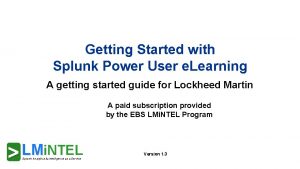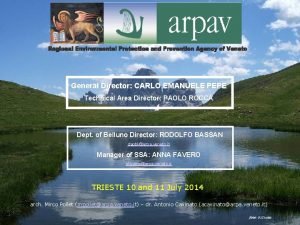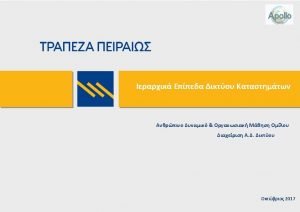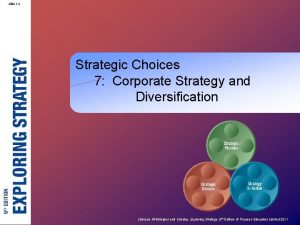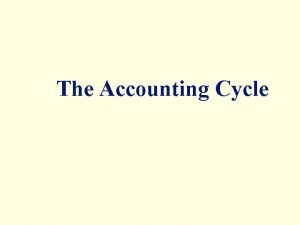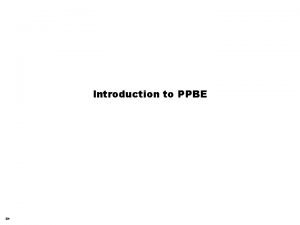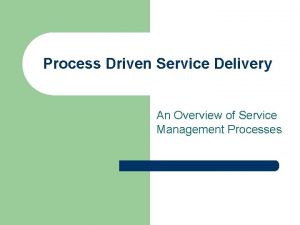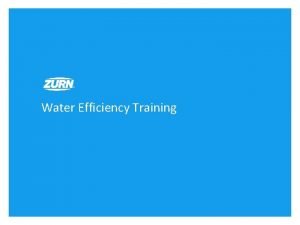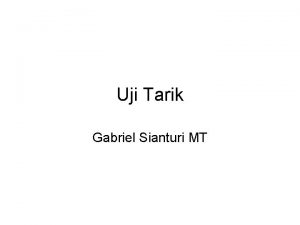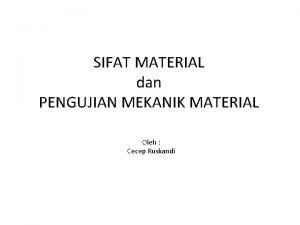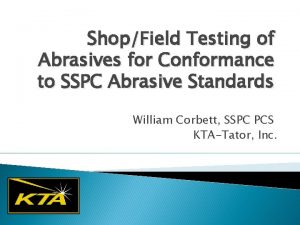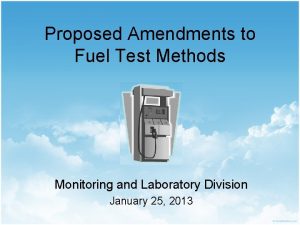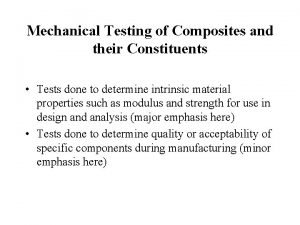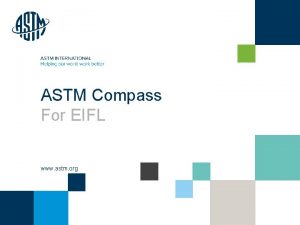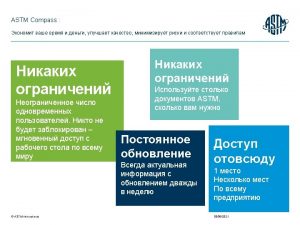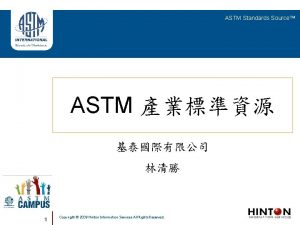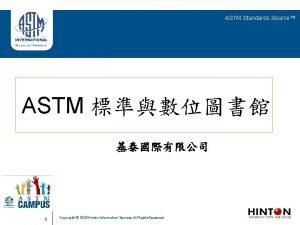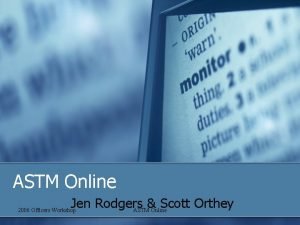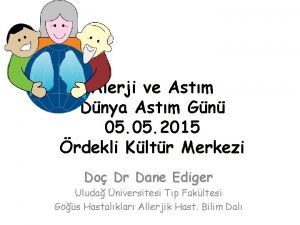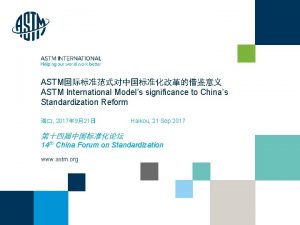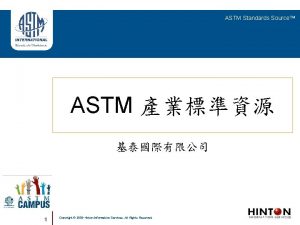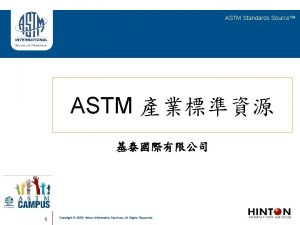ASTM Overview Process Infrastructure Mary Mikolajewski Manager Technical















- Slides: 15

ASTM Overview Process & Infrastructure Mary Mikolajewski Manager, Technical Committee Operations www. astm. org © ASTM International

What is ASTM? A Proven and Practical System Established in 1898 150 Committees & 12, 500+ Standards 32, 000 members 8, 000+ International Members from 149 countries 7, 100 ASTM standards used in 80 countries Process complies with WTO principles: Annex 4 of WTO/TBT Agreement Industry comes Together Experts, individuals, organizations, academia, regulators, trade associations, consultants and consumers Exchange expertise and knowledge Participating in a transparent process – open to anyone, anywhere Industry driven, Global, Market relevant © ASTM International

Types of Existing Standards Company Standard Consensus among the employees of an organization. Consortium Standard Consensus among a small group of organizations; like-minded companies undertaking an activity to collectively conserve resources. Industry Standard Consensus among the many companies within an association or society. Government Standard Multiple degrees of consensus. Some written by individuals within agencies, sometimes developed with private sector then adopted by reference as mandatory. Voluntary Consensus Standard (ASTM sits here) Consensus is developed by representatives of all sectors that have an interest in the use of the standard (producers, users, and those having a general interest, consumers). Consensus standards, with their broad input, are considered by many as the most technically sound and credible documents. They are often used as the basis for commercial and regulatory action. © ASTM International

Over a Century of Openness How We Work Provide Infrastructure and Tools Templates, Online balloting, Online collaboration areas, meetings support, managers, administrative support, editors, promotional support Industry comes Together: Exchange expertise and knowledge Participating in a transparent process – open to anyone, anywhere Staff does not write standards, remain neutral © ASTM International 150 main committees plus 2, 020 subcommittees November 2020 4

Technical Committee Structure v. Formed to address specific industry subjects Main Committee v. Subcommittees address subsets of specialized Subcommittee subject matter. 01 Subcommittee. 02 Subcommittee. 03 v. Subcommittees organize their expertise into Task Groups to write standards v. Direct Member Participation © ASTM International Task Group WK##### 5

F 38 Unmanned Aircraft Systems Quick facts: Formed: 2003, memorandum agreement with FAA Current Membership: 230+ members (30 regulators) Standards: 15 approved; 25+ in development Subcommittees: F 38. 01 Airworthiness Hardware oriented Safe design, construction, test, modification, & inspection of the individual component, aircraft, or system F 38. 02 Flight Operations Procedure oriented Safe employment of the system within the aviation environment among other aircraft & systems F 38. 03 Personnel Individual, Crew and Organization Oriented Safe practices by the individuals and teams responsible for employing the system Also Requires Infrastructure capable of incorporating this technology safely in the NAS © ASTM International Global Representation Argentina Australia Bahamas Canada China France Germany Italy Korea, Republic of Netherlands New Zealand Norway United Kingdom United States 6

F 38 Unmanned Aircraft Systems Key Standards: F 2908 Specification for Aircraft Flight Manual (AFM) for a Small Unmanned Aircraft System Operations (F 38. 03) F 3002 Standard Specification for Design of the Command Control System for Small Unmanned Aircraft Systems (s. UAS) (F 38. 01) F 3178 Practice for Operational Risk Assessment (F 38. 02) F 3298 Standard Specification for Design, Construction, and Verification of Lightweight Unmanned Aircraft Systems (UAS) (F 38. 01) Under Development WK 63418 Specification for UTM USS-USS functionality (F 38. 02) WK 65041 Specification for UAS Remote ID and Tracking (F 38. 02) WK 65042 Specification for Operations Over People (F 38. 02) © ASTM International Areas Include: Design & Construction Design & Command Design & Performance Production Acceptance QA Batteries Fixed Wing &VTOL Safely Bound Flight Behavior Software Dependability Registration & Marking 7

Balance of Interest Users & General Interest Producers ASTM © ASTM International 8 Technical Committees are balanced. No excess influence by any interest group. Ensures market relevance of the content of standards.

Managing Balance: Voting Rights 1 official vote per interest (company) All are welcome to participate in technical discussions All members receive a ballot and are eligible to vote on technical issues All negatives are considered the same way *Ensures large and small organizational have fair say in the industry. Keeps market competitive and innovative. © ASTM International 9

Process at a Glance © ASTM International 11/28/2020 10

Standards in Industry and Regulation What role do they play? www. astm. org © ASTM International

How Are ASTM Standards Used? Developed voluntarily and used voluntarily Cited in a contract Used by tens of thousands of individuals, companies, and agencies globally Government agency reference them in codes, certification, regulations, and laws © ASTM International

U. S. Legal and Policy Framework National Technology Transfer and Advancement Act of 1995 (NTTAA) Requires federal government agencies to use standards developed by voluntary consensus standards organization when possible Encourages federal government agencies to participate in standards development organizations OMB Circular No. A-119 Reinforces goals of National Technology Transfer and Advancement Act Discourages federal agencies from using government-unique standards “A voluntary consensus standards body is defined by the following attributes: (i) Openness. (ii) Balance of interest. (iii) Due process. (vi) An appeals process. (v) Consensus” © ASTM International 13

WTO Principles of Standards Development WTO Transparency Openness Impartiality and Consensus Effectiveness and Relevance Coherence Development Dimension © ASTM International Transparency Openness Impartiality and Consensus Effectiveness and Relevance Coherence Development Dimension 14

Contact Information Technical Committee Operations Mary Mikolajewski Manager, Technical Committee Operations T: +1 -610 -832 -9678 E: mmikolajewski@astm. org www. astm. org Global Offices: © ASTM International Canada Belgium Peru China 15
 Getting started with splunk
Getting started with splunk Mary wollstonecraft mary a fiction
Mary wollstonecraft mary a fiction Technical area manager
Technical area manager Senior manager vs general manager
Senior manager vs general manager Portfolio manager synergy manager parental developer
Portfolio manager synergy manager parental developer Accounting process steps
Accounting process steps What is ppbe
What is ppbe Service delivery process in it infrastructure
Service delivery process in it infrastructure Astm d6284
Astm d6284 Deformasi
Deformasi Advantages and disadvantages of standard penetration test
Advantages and disadvantages of standard penetration test Standar spesimen uji tarik astm e8
Standar spesimen uji tarik astm e8 Astm d7393
Astm d7393 Astm d7754
Astm d7754 Rock solid septic
Rock solid septic Mechanical testing of composites
Mechanical testing of composites
